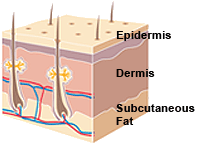Epidermis
/ɛpʌdɝmʌs/
1. [noun] the epidermis is the outermost layer of the skin. It’s thin but durable and acts as a protective barrier between your body and the world around you. The cells that make up the epidermis are continually being shed and replaced by new cells made in the lower levels of the epidermis. The primary function of the epidermis is to protect your body by keeping things that might be harmful out and keeping the things your body needs to function properly in. Bacteria, viruses and other infectious agents are kept out, helping prevent infections on your skin. Water and nutrients are kept in for the body to use. Body parts that are more susceptible to injury, like the soles of your feet and palms of your hands , have a thicker epidermis for even better protection. See https://www.healthline.com/health/epidermis-function ; Accessed June 10 2019 Image source: aad.org Accessed June 10 2019
Source: https://www.healthline.com/health/epidermis-function

Frequently Asked Questions
How does the foot’s outer skin layer differ from the skin on less-utilized body parts?
The sole’s epidermis is naturally thicker than in other areas, offering extra protection and durability to withstand the stresses of standing, walking, and daily impact.
How does the Greek origin of the term ‘epidermis’ aid understanding in foot care?
‘Epi’ means ‘upon’ and ‘dermis’ means ‘skin’, reminding us that this outer layer sits atop and shields the underlying structures of your feet during everyday activities.
Why might the outer skin layer on your feet feel tougher than that on other parts of your body?
Regular contact with hard surfaces and constant pressure from walking lead to natural thickening of the epidermis on your feet, which helps guard against friction and minor injuries.